“HUMANS OF
THE WORLD”
ANNOUNCING THE WINNERS
We’re delighted to present the results of our December competition judged by photography writer and editor Rachel Segal Hamilton, who has worked for organizations such as The Royal Photographic Society, The British Journal of Photography, Aesthetica, Photoworks and Canon.
“When we’re connected to others, we become better people.” – Randy Pausch
What does it mean to be human today? There are of course 7.9 billion answers to that question and counting, each answer a multifaceted combination of joy, hope, sadness, fear and everything in between. The word “sonder” comes to mind – the realization that each random passerby is living a life as vivid and complex as our own.
And that’s exactly what’s hinted at here, in a selection of images from 20 talented photographers working across the globe and across a range of genres. We see familial love and connection, resilience in the face of adversity, tradition, superstition, the questioning of gender constructs, work and play… Through varied subject matter and flawless technique we glimpse into 20 or more such vivid and complex lives, many a thousand miles away – both geographically and metaphorically – from our own. As Pausch puts it so well in the opening quotes, we hope connection creates understanding.
Congratulations to the selected photographers, and thank you to everyone who submitted. You can join the discussion on Facebook and Instagram.
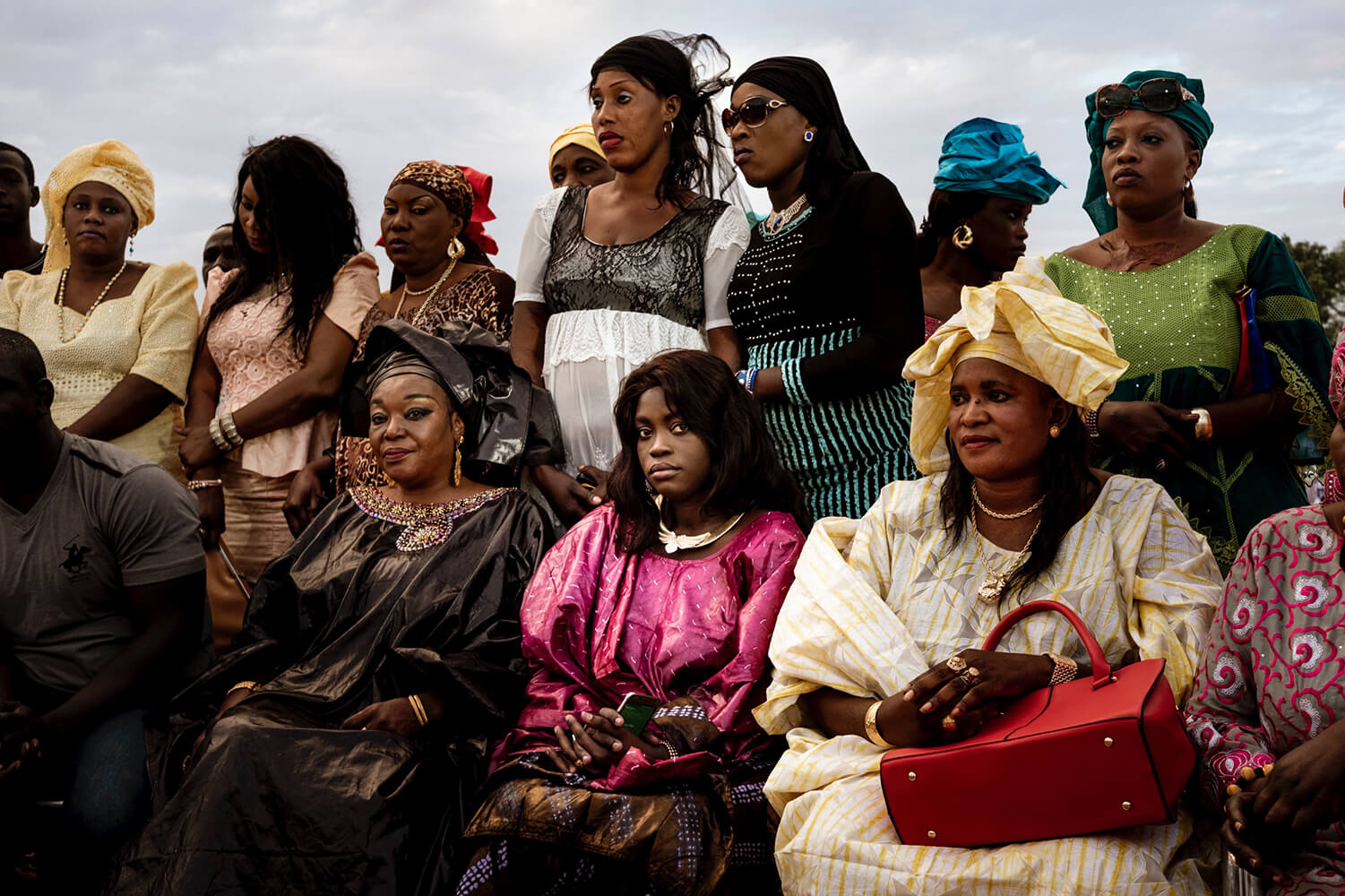
“We are looking at an audience – a group of well-to-do Senegalese women near Dakar who are ostensibly watching a lamb fight. Except that isn’t the whole story. Some are looking beyond the frame, some at each other. The younger woman at the centre of the frame is seemingly locking eyes with the camera. So arresting is her gaze, it’s almost a portrait of her alone. This picture speaks to themes of female social status, of crowd psychology, of seeing and of being seen.” – RACHEL SEGAL HAMILTON
Photographer statement – “A Senegalese group of upper-class ladies is watching a traditional lamb fight close to the capital Dakar. Fighters, Trainers, Sponsors – the whole sport is directed by men. Women are not involved at all. They accompany their husbands and watch the fight as they have to.”
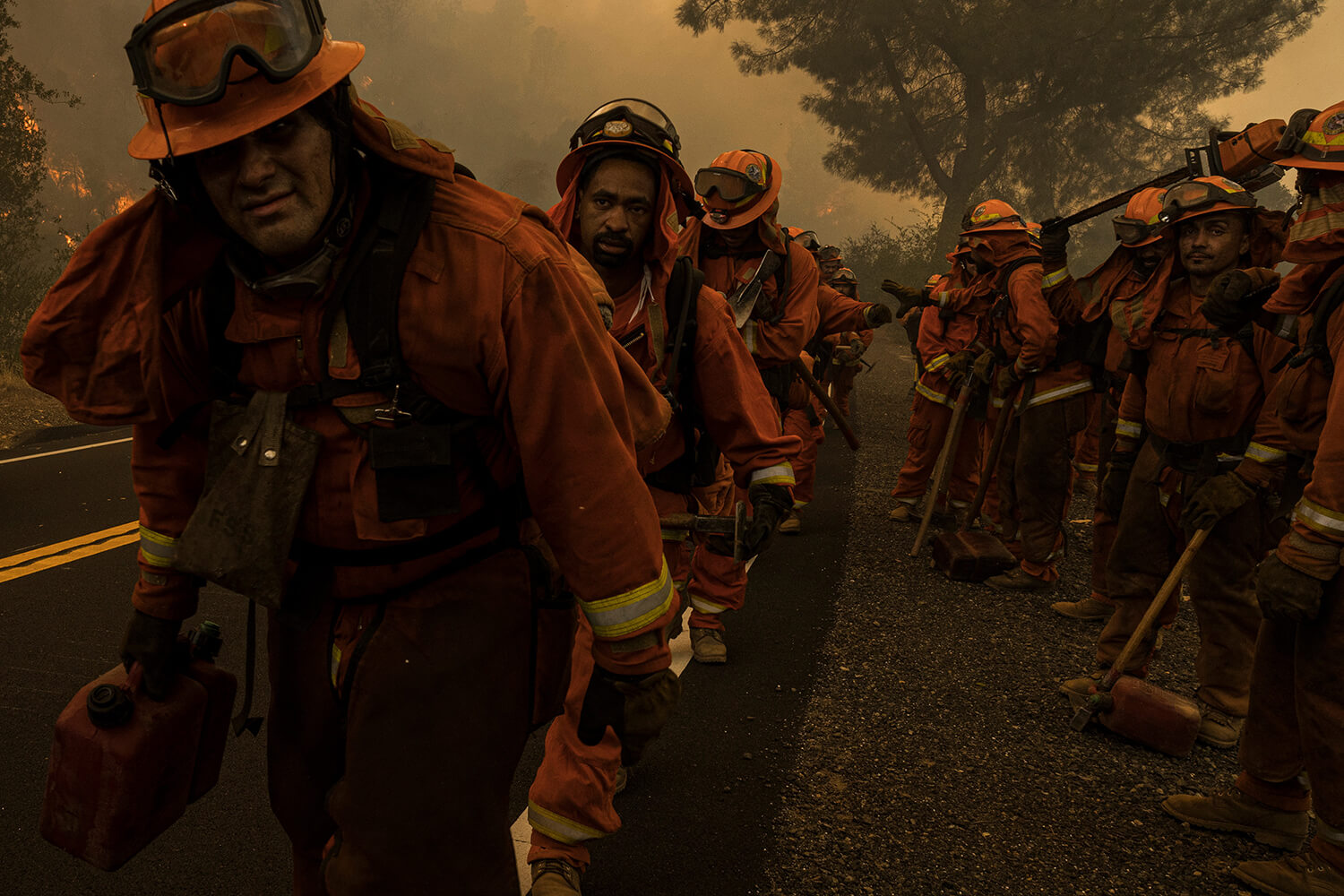
“Every year now when wildfire season comes around, with grim inevitability apocalyptic images of the flames engulfing California flood our newsfeeds. This gritty shot from August 2020 captures a less visually spectacular but nonetheless disturbing side to this symptom of the climate crisis. Here, the focus is on people, namely a team of firefighters who have arrived to tackle a blaze in San Francisco. Their weary expressions, the slightly vertiginous camera angle, the smoky, amber-tinged sky contribute to a visceral sense of unease.” – RACHEL SEGAL HAMILTON
Photographer statement – “Inmate firefighting crews arrive to a wildfire burning near San Francisco’s Hetch Hetchy Power and Water plant along Hwy 49 in Moccasin, California, on Thursday, August 20, 2020. More than 9,000 fires burned 4,359,517 acres (1,764,234 hectares) in California in 2020. Shortly after creating this image, I returned home just a few miles away to collect my dog and belongings to evacuate.”
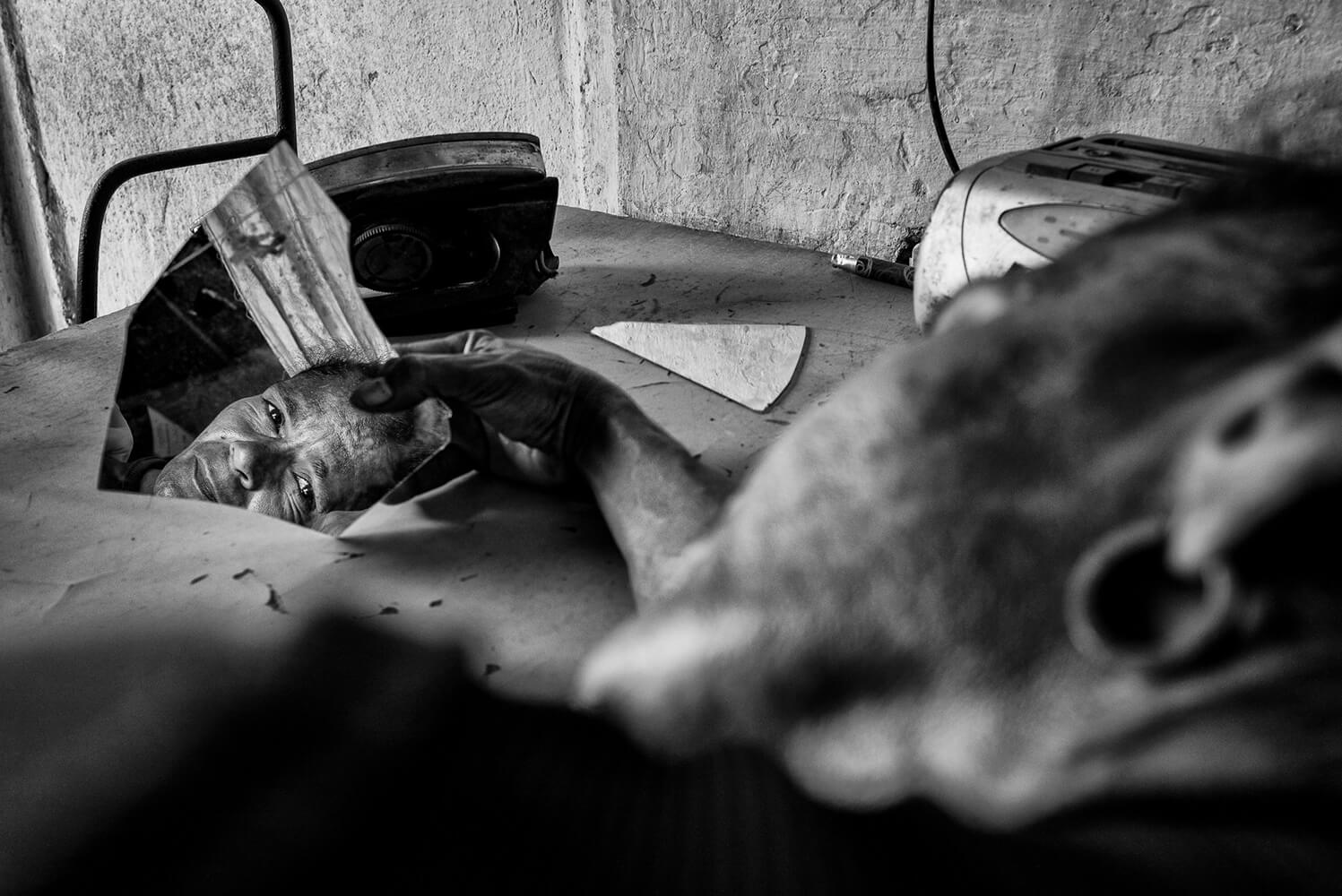
“This image works almost like a riddle. I had to look at it for some time to figure it out. At first it seems to be of a man poking his head out of a table but, slowly, surely, an optical illusion reveals itself – the face is the man’s reflection seen in the shard of mirror he holds in his hand. The viewer is thrust into the position of the subject, a strange and immersive experience, and the subtle, poetic statement adds a level of intrigue.” – RACHEL SEGAL HAMILTON
Photographer statement – “He had committed a crime, she was heartbroken. Missing him had become her reality. I could see sadness in her eyes, I am certain she saw fear in mine. As the sound of female voices traveled through the wall from the small house next door, she whispered and pointed: ‘she is the one, she is evil’. Right there I knew I had to pretend to be someone else.”
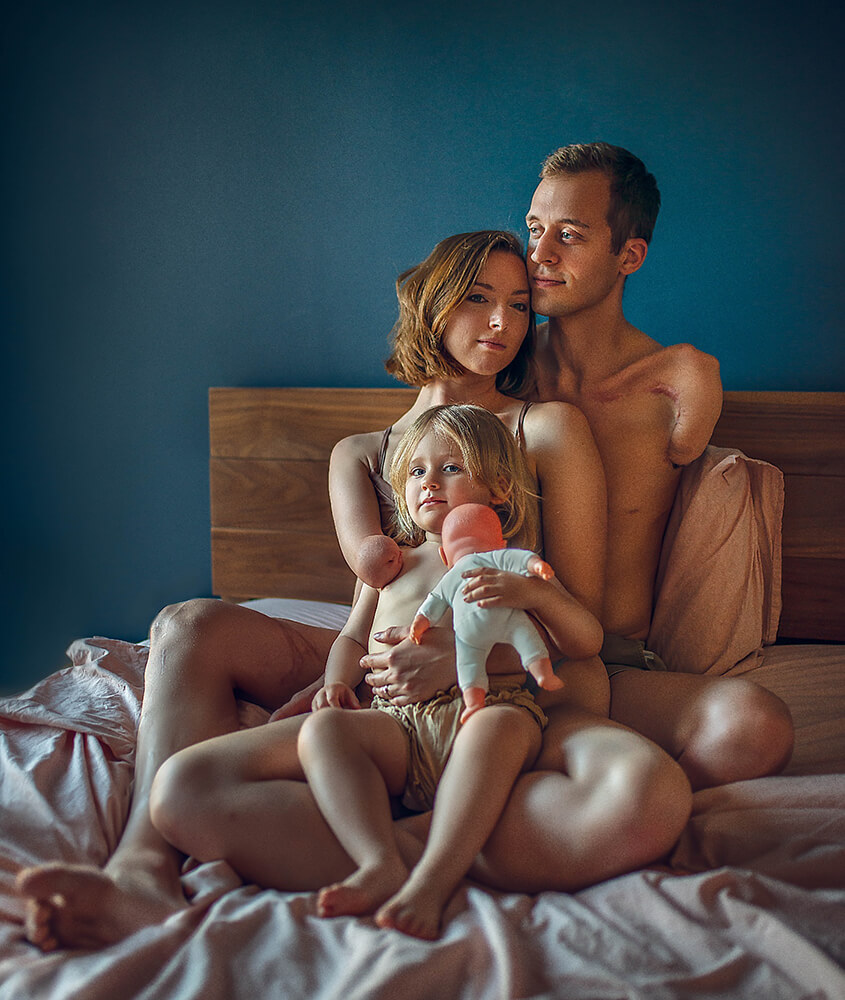
“A warm, loving family portrait of Ashley, James and their two-year-old daughter, Elara, from a series in which the photographer is intent on building an inclusive visual study of what it means to be human today. The image feels formal and yet naturalistic, the rumpled sheets adding to a sense of relaxed intimacy.” – RACHEL SEGAL HAMILTON
Photographer statement – From the series Change the Conversations. “My 8-year-old daughter returned from school one day and asked me if she is “beautiful. As a girl child who grew up in a patriarchal society back in a small town of India, I have battled for all of my life with the constructs of beautiful or ugly; boy or girl; normal or abnormal, rich or poor, pink or blue… this world for me has always been divided in binaries, until my daughter started to grow up with a similar world view.
And so, I started this series as an effort to work towards the expansion of humanity. A world without exceptions. A world that moves away from binaries. It is an ongoing series.
Image: Ashley, James, Elara – “I have wondered what it would be like to have more than one child, if I need to hold them both tight at the same time,” James said as he laughed casually. 9 years ago, James lost his arm and leg in an accident. Ashley is a congenital amputee. Which means that she was born with the lower part of her right arm missing. “I didn’t want to have children because I thought I wouldn’t be able to hold her. How will I support her head while feeding? How will I tie her shoe laces? Or change her clothes… but it all worked itself out. Elara realises that mummy and daddy just have to do things differently. So she works with us on solutions.” “You know how it is… with being limb different… you just have to be persistent.” Ashley is a successful model and an advocate for families that have a limb different member, which includes sharing helpful tips through her social media platforms. Since his accident, James has worked with Japanese gaming giant Konami to personally design and develop his own advanced bionic arm – earning himself the nickname Metal Gear Man. Since then, he’s become a speaker, BBC presenter and model. They have the most beautiful 2-year-old daughter Elara, who truly is a ray of sunshine.”
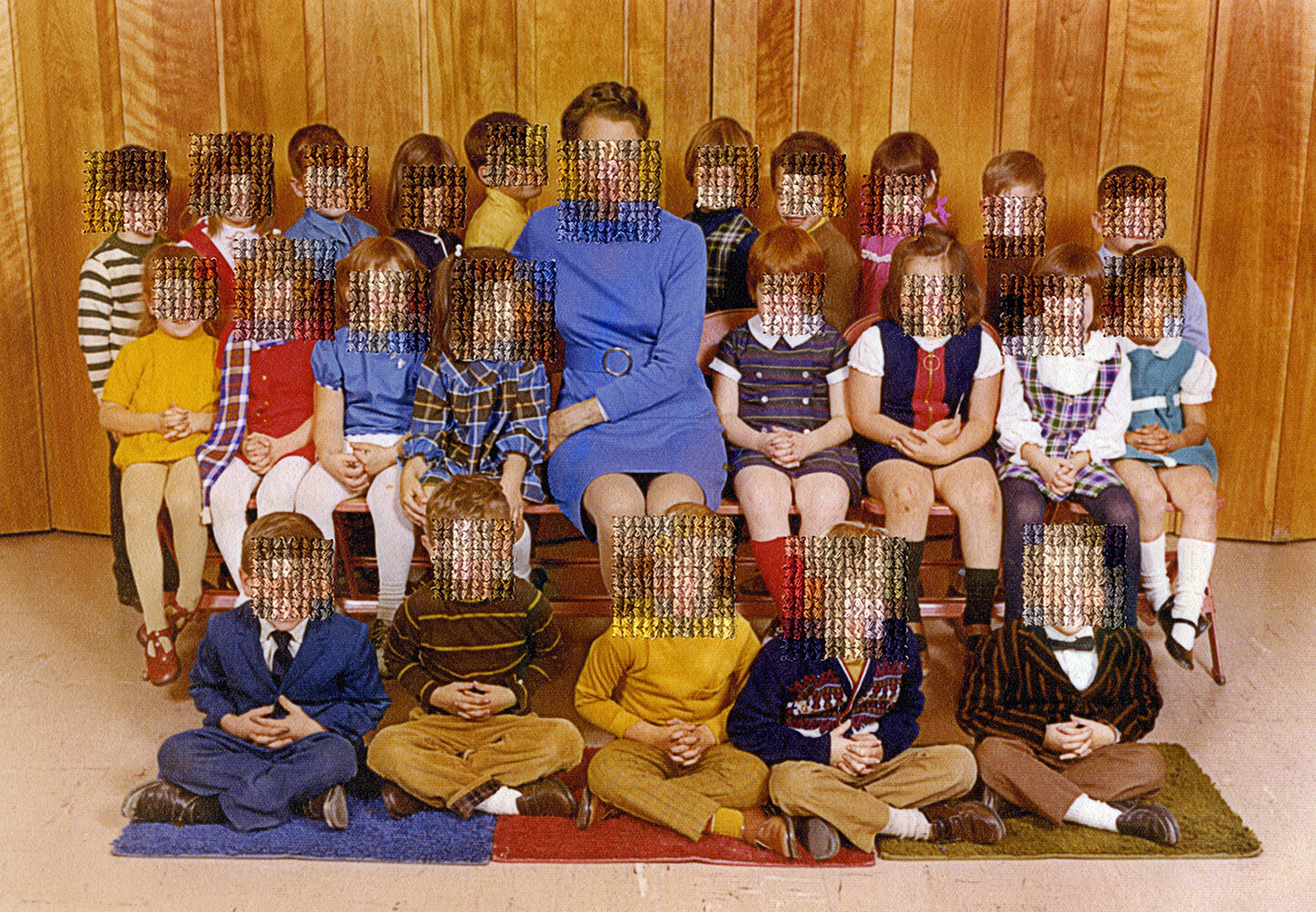
“Stitches hand embroidered by the photographer obscure the identities of the pupils and teachers in this archival class photo from the 1970s. School photographs have an apparent universality – the neat rows, clasped hands and crossed legs are pure nostalgia – which belies differences of era, place and circumstance that make themselves known in subtle gestures. It makes for a creative and memorable mixed-media composition.” – RACHEL SEGAL HAMILTON
Photographer statement – From the series Reunion. “Group I, Hand Sewn Archival Ink Jet Print.
Most recently, I have been working on an on-going series of hand-embroidered photographs based on found elementary school class pictures from the 1970s. This project continues my interest in the relationship between photography and memory and grew out of an earlier project, “Time Spent That Might Otherwise Be Forgotten,” an archive of embroidered personal and family photographs. In the class photographs, the faces of the students, or what would normally be the main focal points of the image, are obscured with cross-stitch embroidery made to resemble the digital pixel structure of the image. By obscuring what would typically be the most important parts of the image, otherwise overlooked details are brought into focus such as body language and other embodiments of social convention. I am interested exploring these details to reveal not only the relationships between the various figures, but also how, even at a very young age, children were taught and instructed to pose in particular ways, often based on gender. I am interested in this time period not only because it is my own generation, but because it is the last generation to have a childhood unclouded by digital technology. These class pictures were taken before camera phones and digital cameras and at a time when having one’s class picture taken was a more formal occasion- something that has been lost due to the ubiquitous nature of digital photography- making participants more conscious of the photograph as an aspirational vehicle for impression management.”
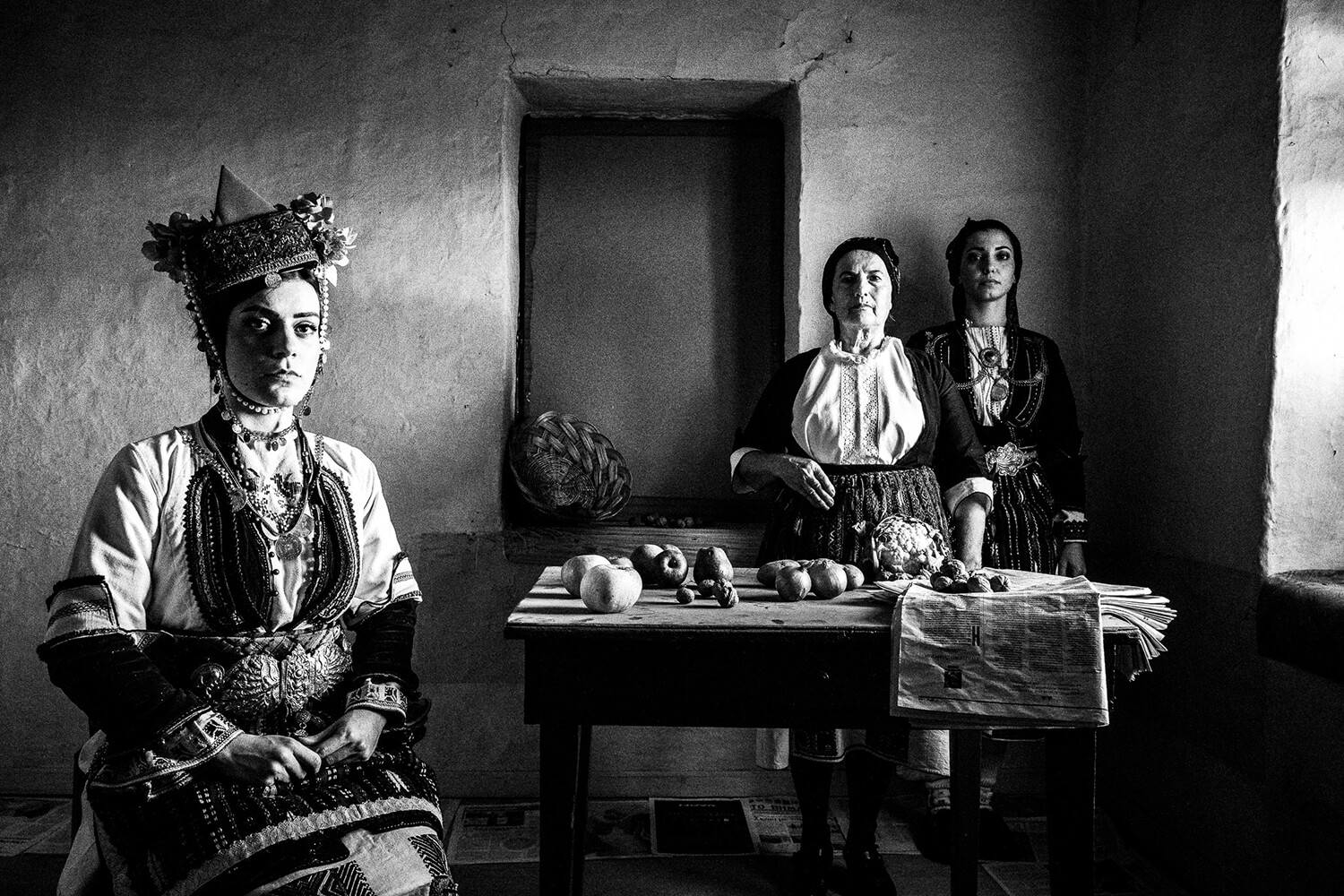
“Besides the beautifully ornate traditional Greek costumes, there’s something really captivating about the staging of this photograph. The position of the three women in relation to one another, the slightly stiff formality of their postures and the other elements in the composition – the fruit on the table, the textured walls of the room – all offer a rich, rewarding visual encounter.” – RACHEL SEGAL HAMILTON
Photographer statement – From the series Caryatis: A survey of Greek costumes in the 21st century. “Caryatis is a study on the Greek female traditional costumes. Greece is home to a wealth of traditional costumes from different periods of time, inspired by its own as well as many other cultures. I have started this project a couple of years ago, following my project on the Greek tradition ‘Ethos’, but as of lately, I managed to get some help from a private patron, so the idea now is to swipe through every corner of Greece and discover all the costumes available. I am also working with academic advisors from the Kapodistrian University of Athens who help me evaluate the authenticity or the genuine replication of the costumes. The idea is to create work to be presented as a book and/or exhibition.”
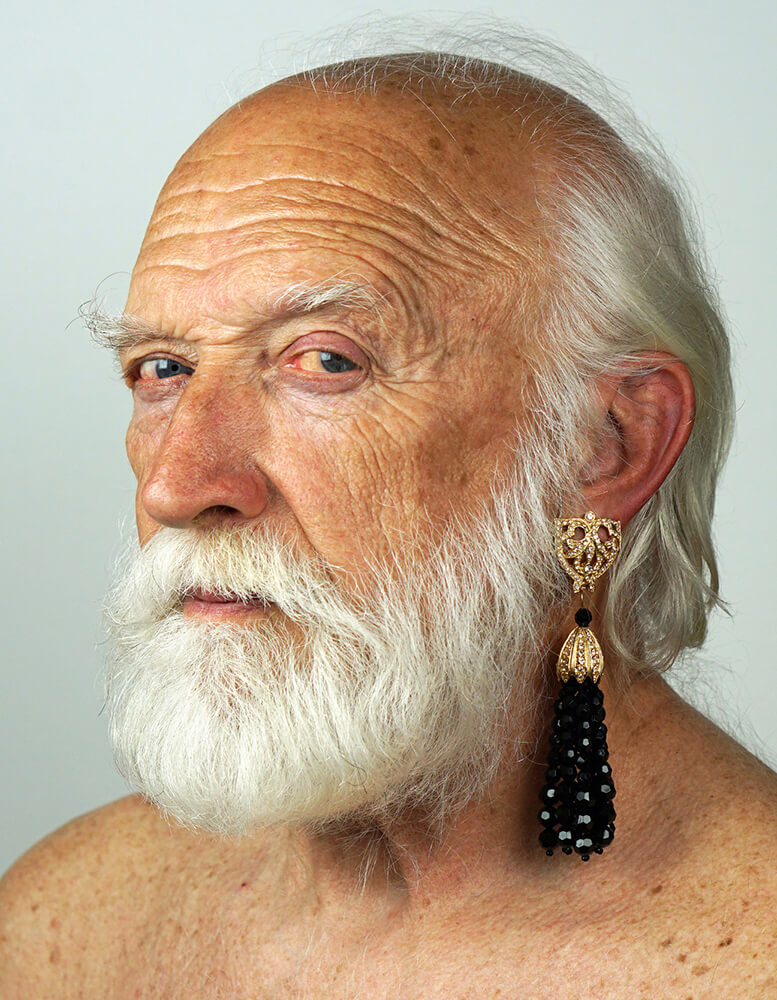
“The twinkle in this man’s eye is matched by the sparkle of his bling. This white-bearded fellow is one of 60 male-identifying people from Arkansas photographed wearing clip-on earrings from a collection amassed by the image-maker to explore perceptions of masculinity. A simple but powerful inquiry into the persistence of gender stereotypes in the contemporary world.” – RACHEL SEGAL HAMILTON
Photographer statement – From the series Men with Earrings. “A series of 60 portraits of people in my local community of Eureka Springs, Arkansas who identify as male, wearing clip-on earrings. Years ago I purchased a large collection of vintage clip-on earrings and during that time period would occasionally select and don different pairs before going out in public – to the grocery store, the movie theater or waiting in the doctors office, etc.
I was always surprised by people’s reactions to the simple ear-bobs worn by a man – from averted eyes, embarrassed giggles, to compliments, hostile looks and even homophobic shouts. Thus became the impetus and inspiration to photograph men wearing clip-on earrings, a slight gender bending look that examines masculinity, gender roles, and man’s projected feminine side.”
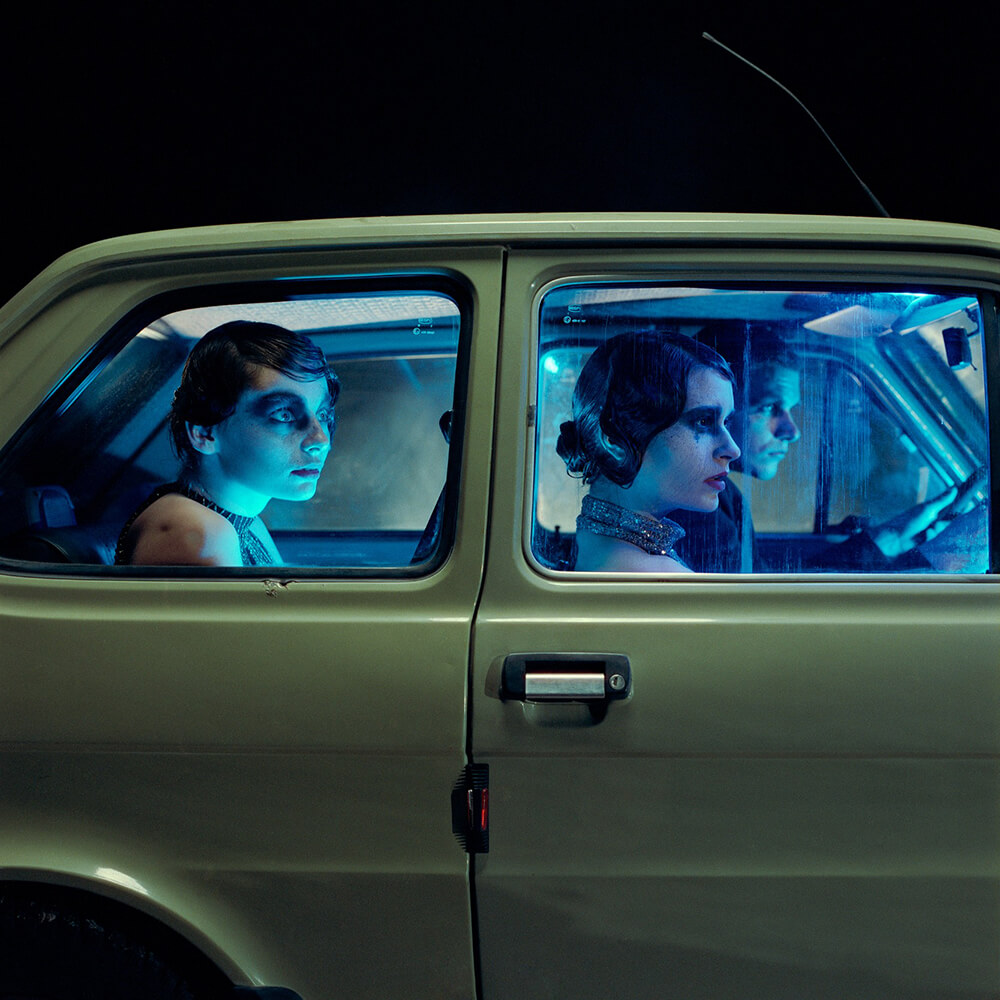
“Maybe it’s the eerie light emanating from inside the retro-looking car, or the smoldering eye makeup worn by the two young women, but this resembles a still from a movie. A horror movie set on Halloween about teenage high jinx gone awry… Stylish, theatrical and intriguing, this is a picture that stays with you, posing more questions than it answers, and leaning towards a more playful, theatrical side of existence.” – RACHEL SEGAL HAMILTON
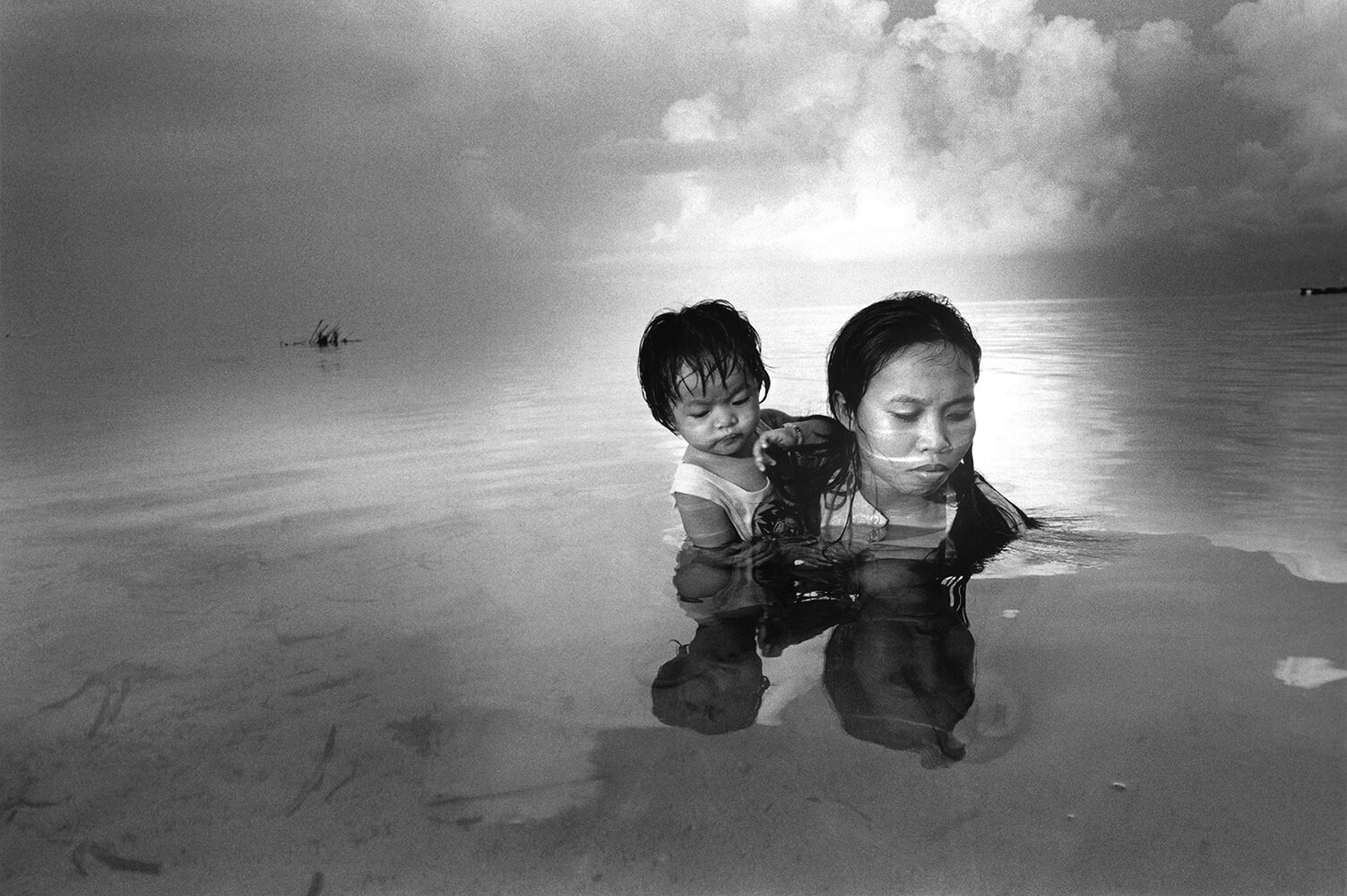
“Mother and child – I presume, the image was not captioned – drift together as one in a vast body of water, emphasised by the wide-angle perspective. I read it as a kind of metaphor for the all-encompassing experience of parenthood, the way that bond recasts everything else in the world. For me, the most touching element is the way the child is nonchalantly playing with their mother’s hair, as if it’s an extension of their own body. Which, in a way, it is.” – RACHEL SEGAL HAMILTON
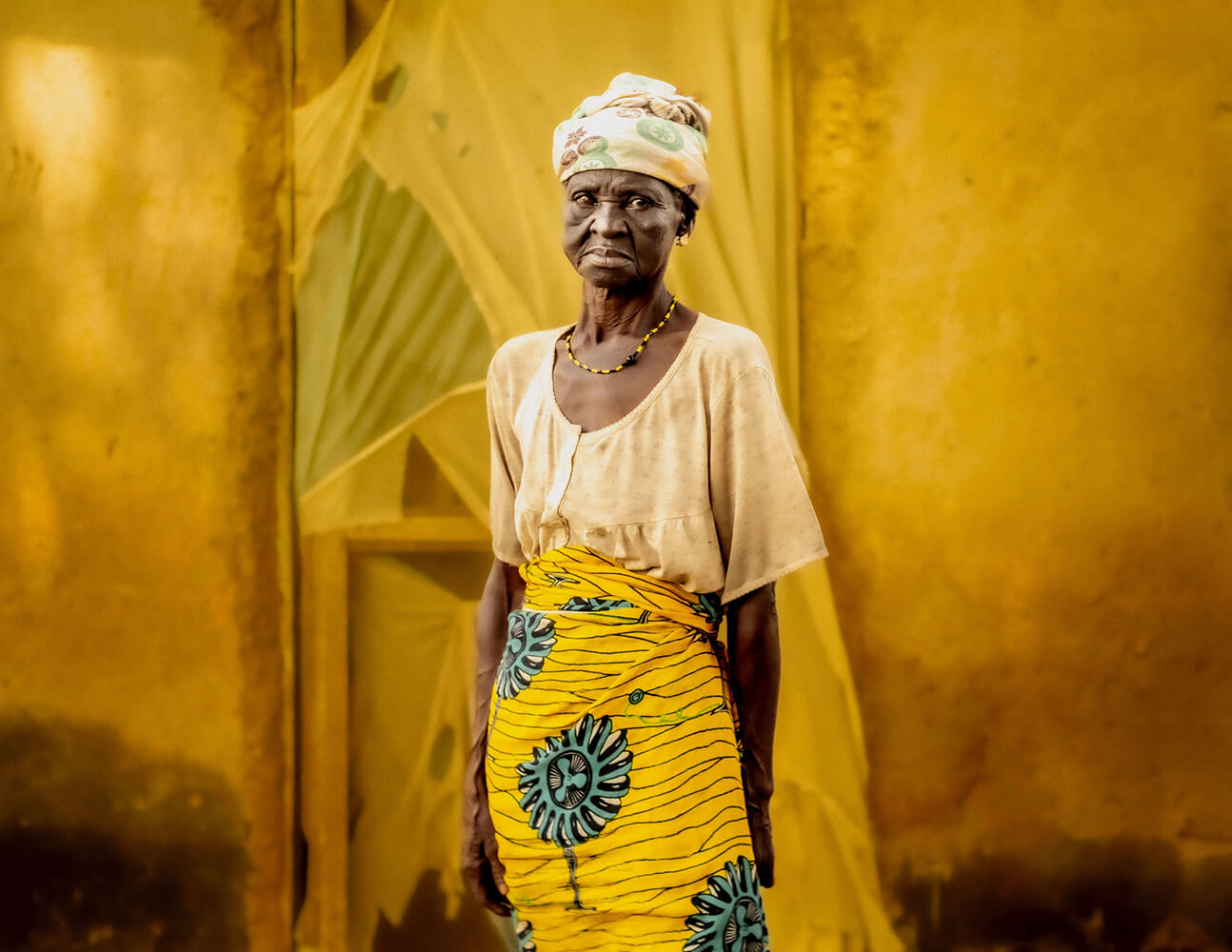
“In contrast to the cheerful yellow of the backdrop, picked up in the elderly woman’s skirt, this is a portrait of someone who has suffered great hardship in life. Issah Larry, photographed for the series Cursed, lives in a camp for women in Ghana who have been accused of witchcraft. This sensitive, beautiful picture portrays Issah as an individual with her own story to tell – one that for many of us in other parts of the world is shocking to believe has a place in our modern existence.” – RACHEL SEGAL HAMILTON
Photographer statement – From the series Cursed. “Elderly women of the Kpatinga Witch Camp, Northern Ghana. Excommunicated and accused of being a witch or possessing witchcraft they were forced to abandon their family and village life. Having to live the remainder of their life in a spartan hut with no running water, electricity or loved ones. They can’t leave the camp without permission. This is to protect them from the local villages that surround these camps. The accusations are most of the time based on lies and very often a convenient way to get rid of somebody.
Image: Issah Larry from the Wazim community. Accused of appearing in someone’s dream as a witch and possessing witchcraft after a cow died.”
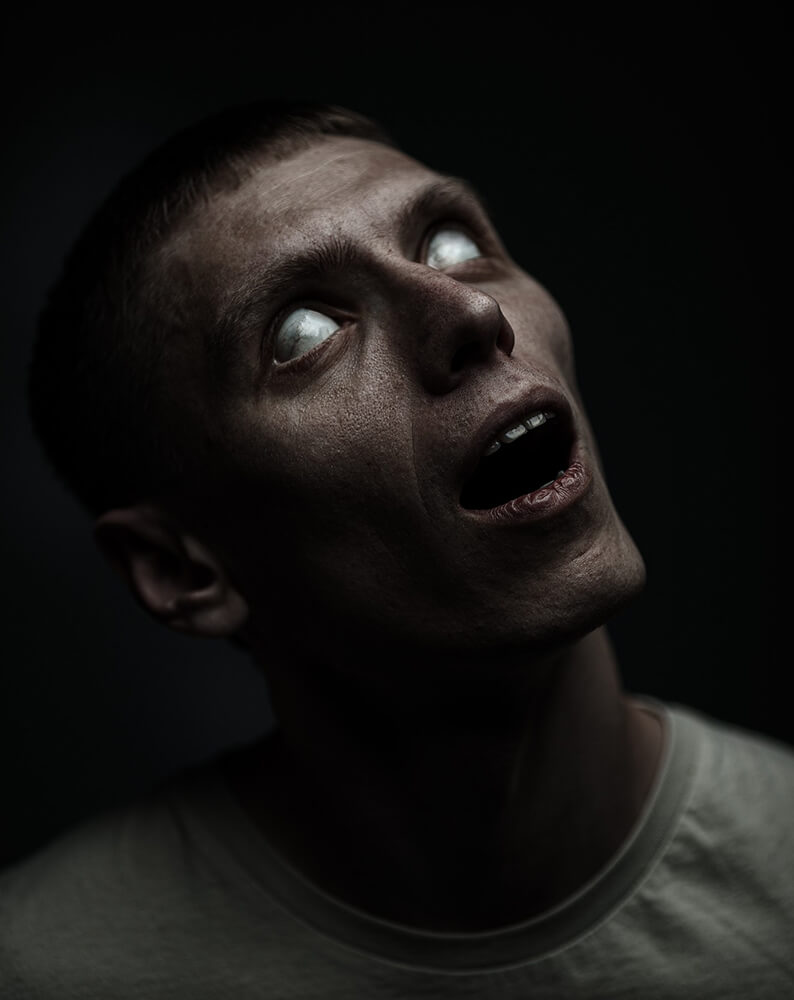
“Through strong chiaroscuro and tight framing, this is an intense and striking portrait that seizes your attention and leaves you curious about the context. There was no statement submitted alongside it so I wonder, who is the man pictured here, and what is his story? Is this documentary photography, or something else? I’d like to know more, but as it stands it stops me in my tracks.” – RACHEL SEGAL HAMILTON
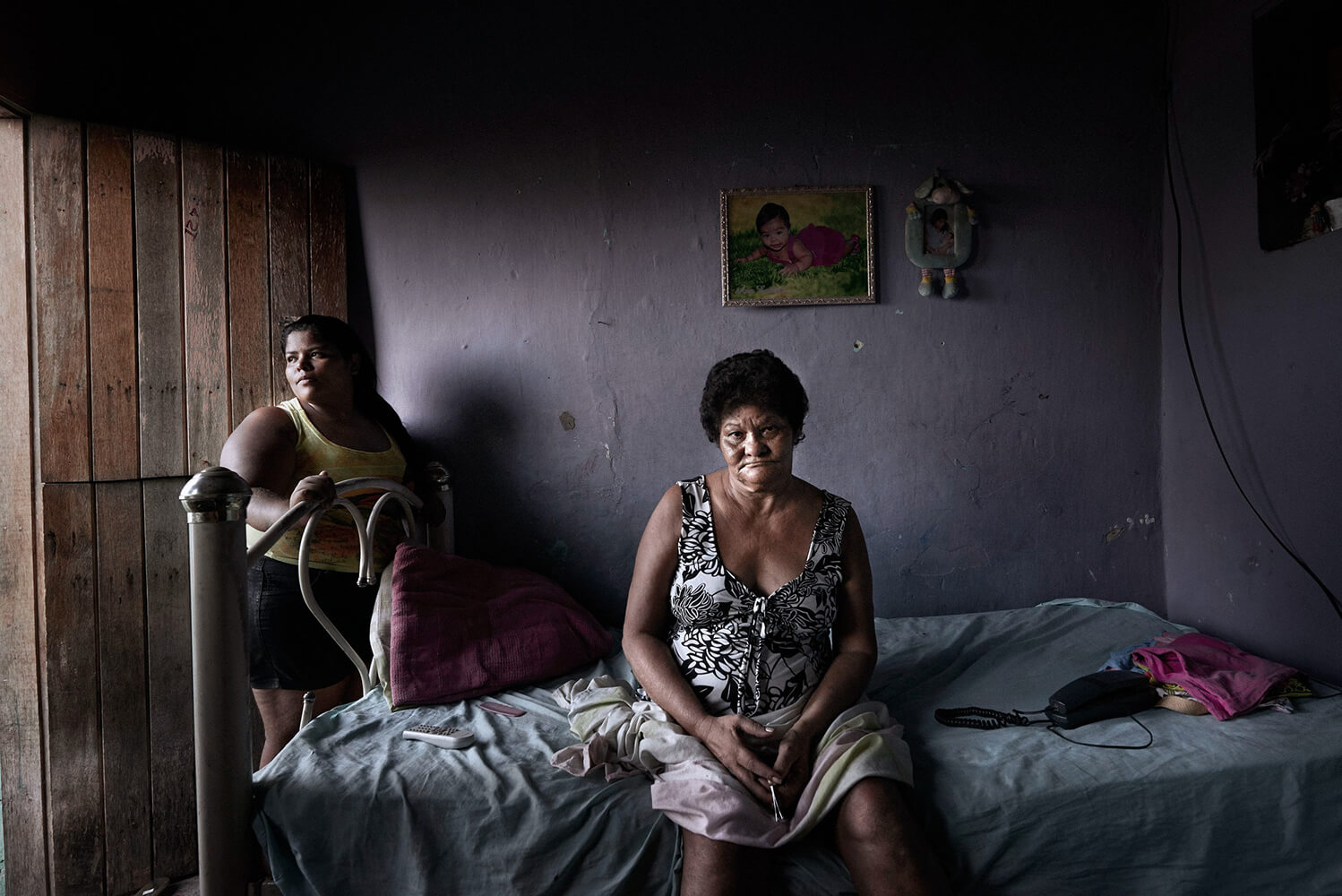
“When viewed alongside the photographer’s statement, this is not an easy image to digest – describing a terrible and regrettable story of addiction and desperation. It is however a beautifully and aptly constructed scene, with the dark tones conveying the weight of subject matter, the sparse setting suggesting a hardship, the framed picture of a baby on the wall hinting at more innocent times, the postures and placement of mother and daughter describing an emotional distance, and the rays of natural light shining in, just perhaps, signifying hope and redemption. It is a complex and thoughtful image of a story worth telling.” – RACHEL SEGAL HAMILTON
Photographer statement – “Child survivor of sexual exploitation. The addicted mother sold her daughter to customers for sex. With the money that was earned, the mother was able to buy drinks and drugs. Once clean and years later, she is feeling deeply sorry for what she did to her daughter.”
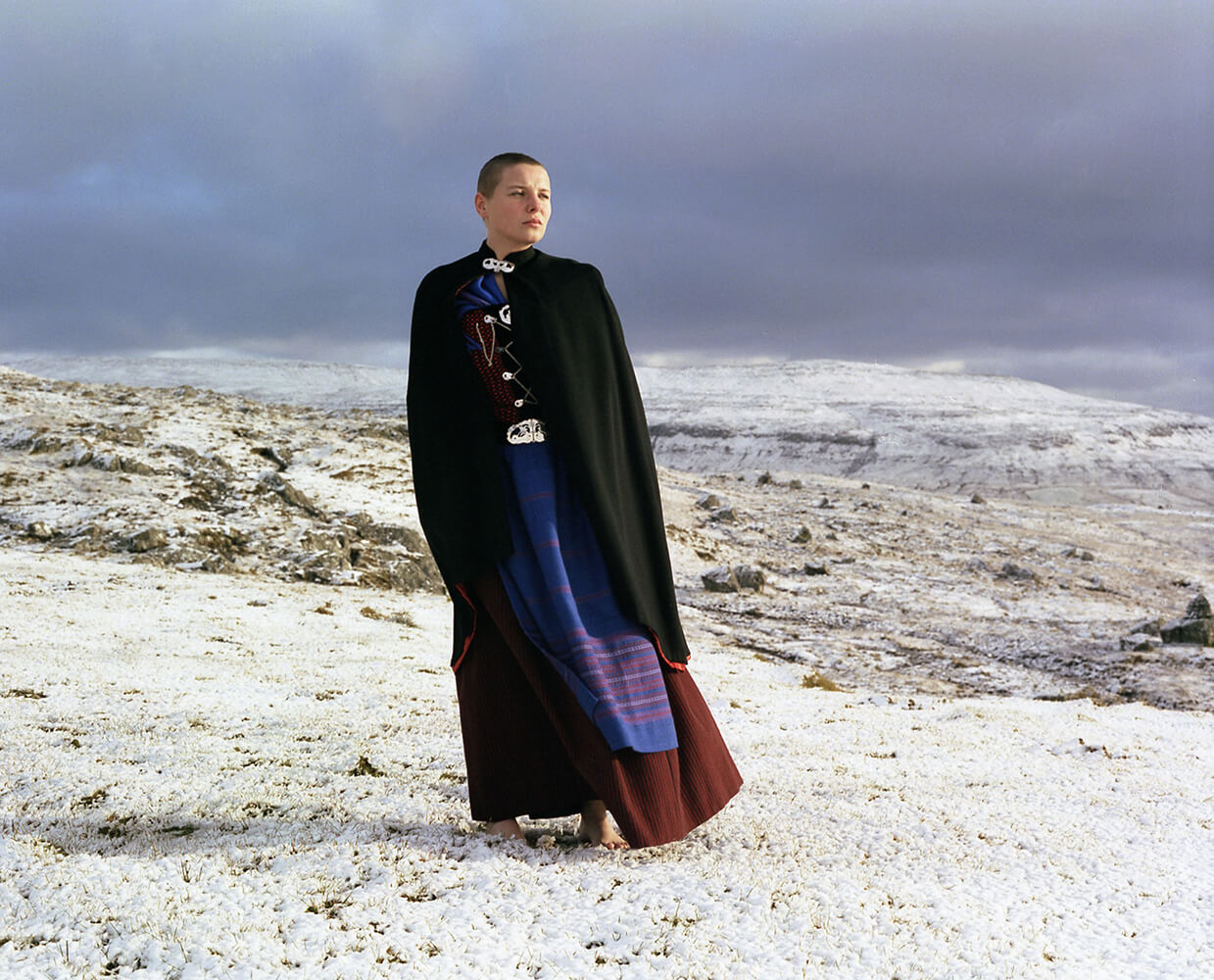
“A woman stands amidst a sparse, wintry landscape, the purplish blue of her dress echoed in the brooding clouds above her head. A breeze is apparent in the movement rippling through the dense material of her clothing but otherwise she is firmly rooted, sure of who she is. This image is from Project Nordess, a collaboration between the photographer and Nordic women who have an immigrant background, who are depicted in places of significance to them. That rooting of person in place is very well done.” – RACHEL SEGAL HAMILTON
Photographer statement – From the series Project Nordess. “A collaboration between photographer Patricia Rodas, Finland and Ilar Gunilla Persson, Sweden.
In a world where mergers and a global mindset are more current than ever, an interest has been aroused in us to focus on women’s identity tied to the society she is living in. These are our inspirations. We want to document how the Nordic woman with an immigrant background, persons who are born women and identify as something else in the spectra of genders and others how they perceives the Nordic mentality, culture, history and everyday life. We want to capture the essence of the person and the places that they hold as special in their everyday lives. Their identity linked to the places they are living in. How do different women define culture and identity and how is this influenced by their historic and cultural background?”
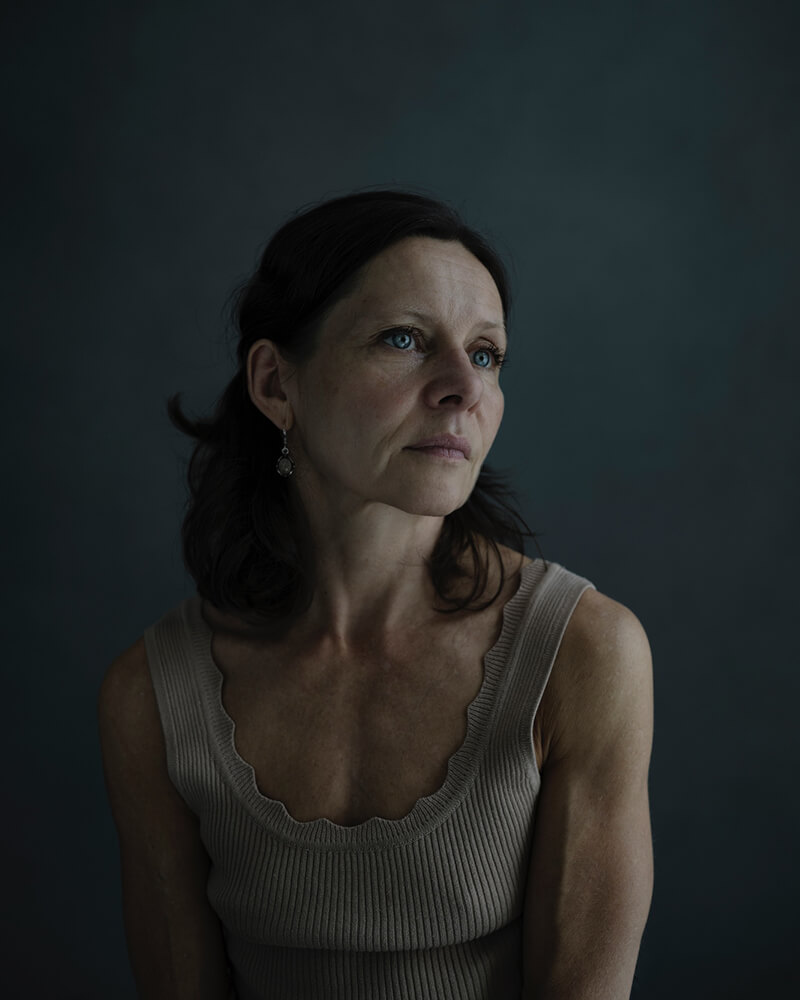
“An enigmatic and empathetic portrait. I’m struck by details – her ice blue eyes, piercing against the muted tones elsewhere, the way her hair is tucked carefully behind an ear, her sinewy arms. I feel like I somehow know this woman, even though I have no information about her to go on.” – RACHEL SEGAL HAMILTON
Photographer statement – “‘In my portraits I am looking for honesty and vulnerability. I believe that vulnerability makes us nicer human beings, and that this makes the world a little more friendly and more understanding. People who show their own vulnerability give the other the confidence that they themselves may be who they are. I am most fascinated when I can see opposite qualities of a person at the same moment. I find this exciting because people are complex. I hope that each portrait touches something in the viewer themselves.”
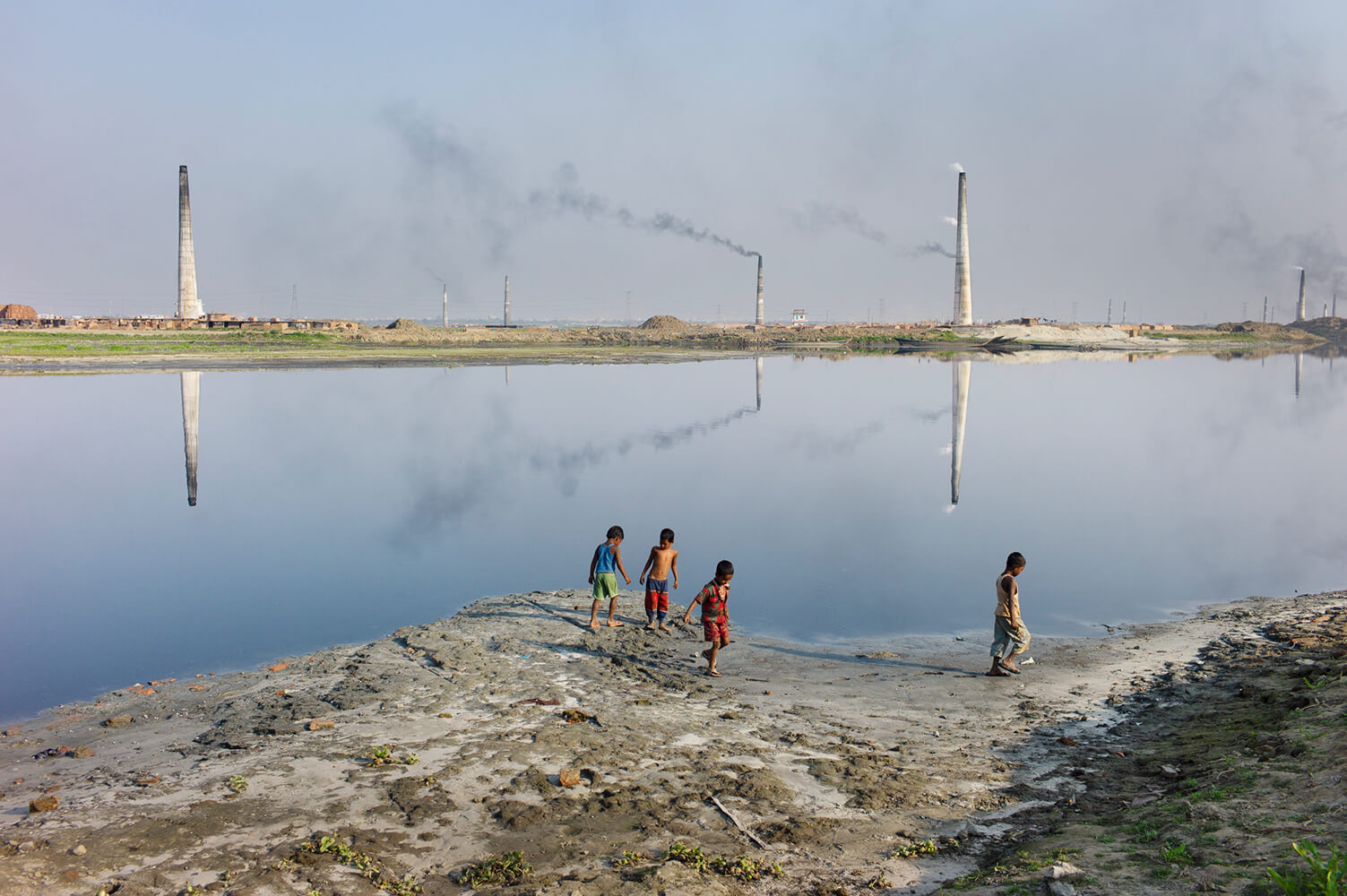
“A quartet of kids gingerly make their way across a rocky shoreline and across the bay, in almost symmetry, tall chimneys puff out smoke. This shot from a documentary project Bangladesh, Defying the Odds, which chronicles the country through a focus on children, cleverly hints at the wider environmental and societal forces that define people and who they will go on to become, especially those new to our complex, damaged world.” – RACHEL SEGAL HAMILTON
Photographer statement – From the series Bangladesh, Defying the Odds. “A photographic project aiming to portrait ordinary people in Bangladesh, with a focus on children and young adults. It is a journey into resilient lives, lingering shadows and youth in transition. It acknowledges Bangladesh’s impressive socio-economic gains since the country became independent in 1971. It also highlights continuing challenges such as child marriage as well as the many adverse consequences of rising sea levels in a country which lies at the heart of the Ganges- Brahmaputra delta, the largest river delta on earth.
My images speak to the effects of our rapidly changing ecosystem on the lives of ordinary people, the growing inequities, the resilience and successful adaptation of a few contrasting with the growing vulnerability and desperation of far too many.”
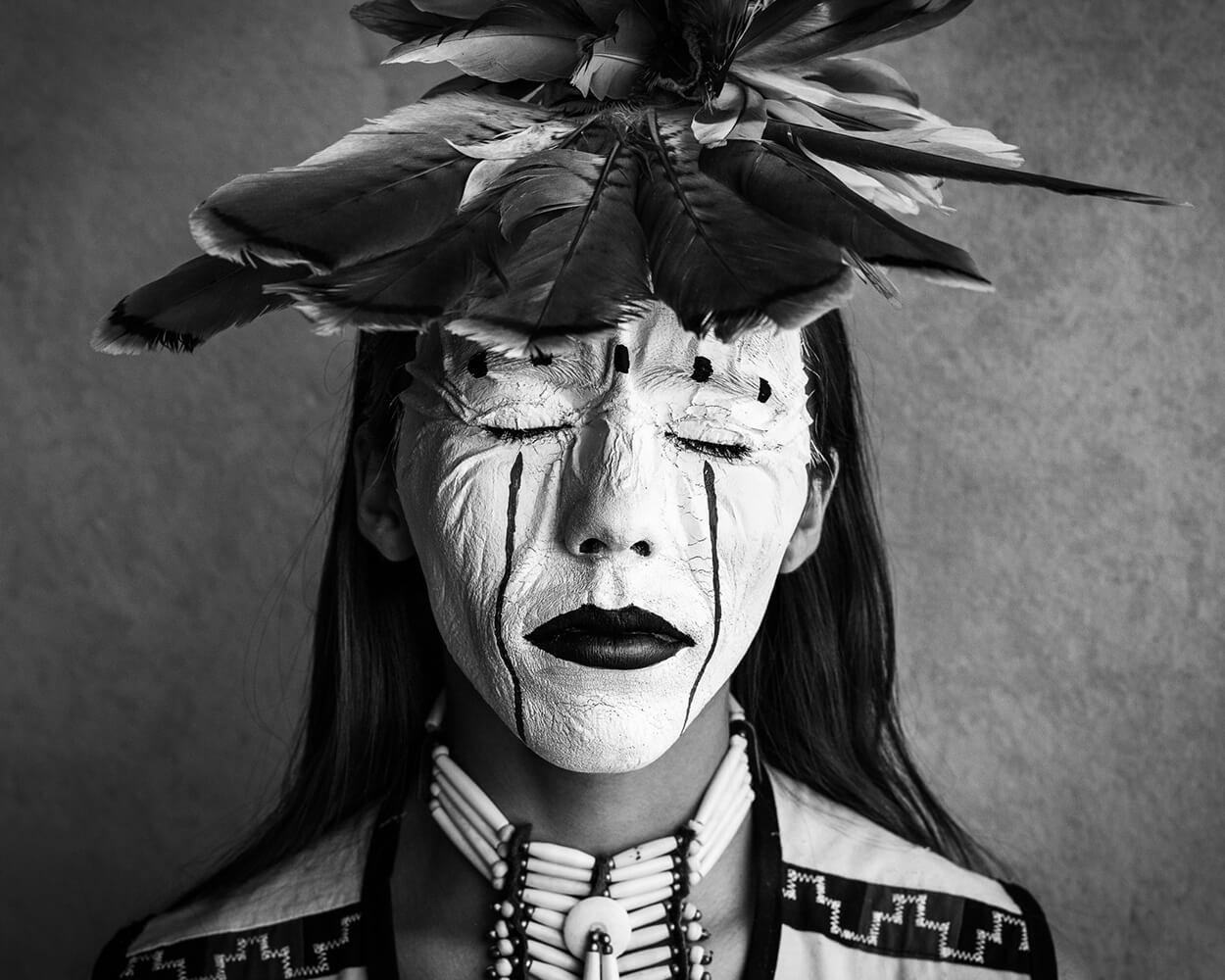
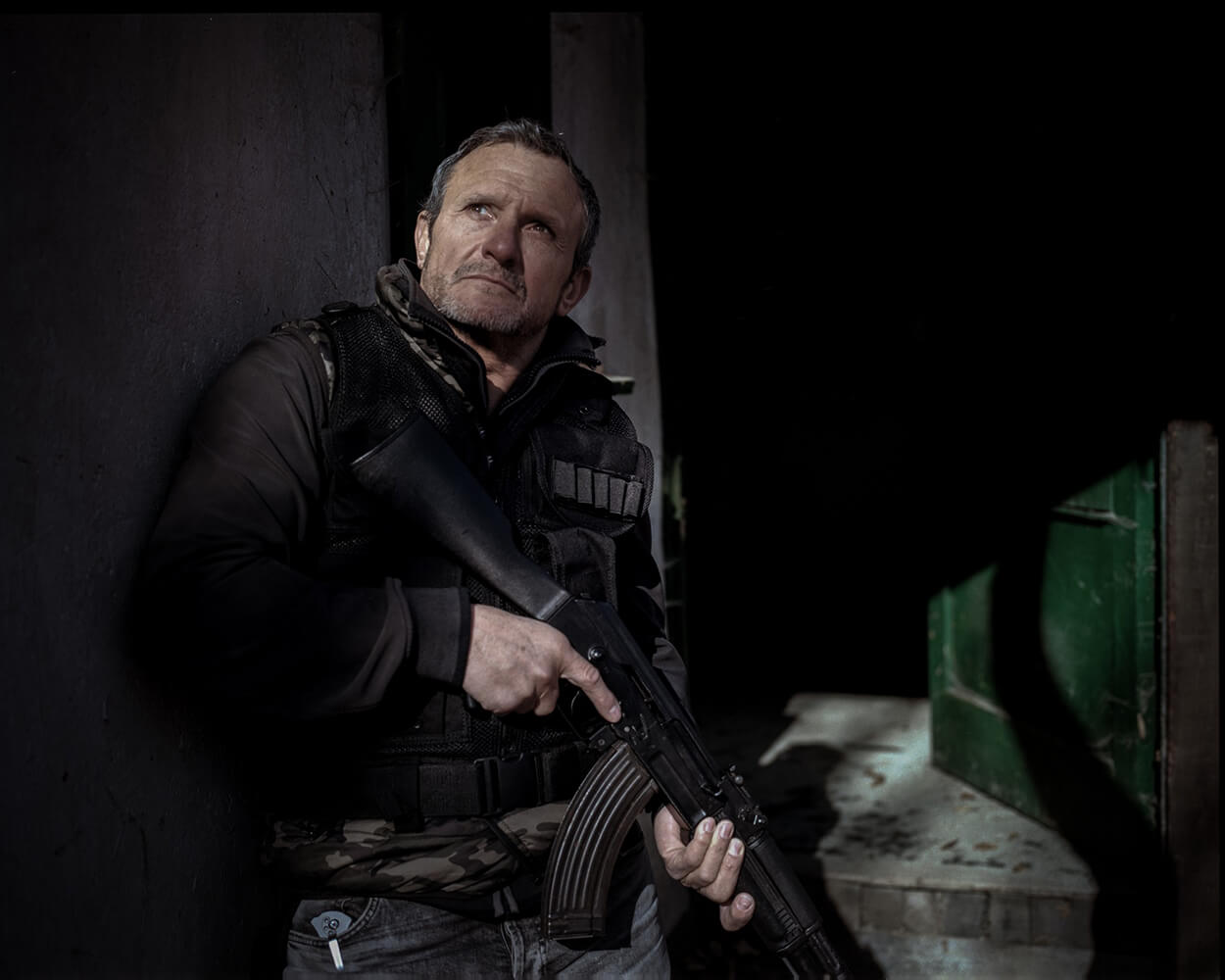
“Friend or foe? That’s the first thing we ask when confronted with an image of a soldier. But, submitted without words, this stirring portrait reminds us of the naivety inherent in this thought. Combat is morally murky, nothing if not complex. The soldier looks up to the top right of the shot, away from his weapon and away from the door, light cutting a strong diagonal. A dash of green in a palette of brown, the door draws my eye. In both a literal and metaphorical sense, I wonder what lies just beyond.” – RACHEL SEGAL HAMILTON
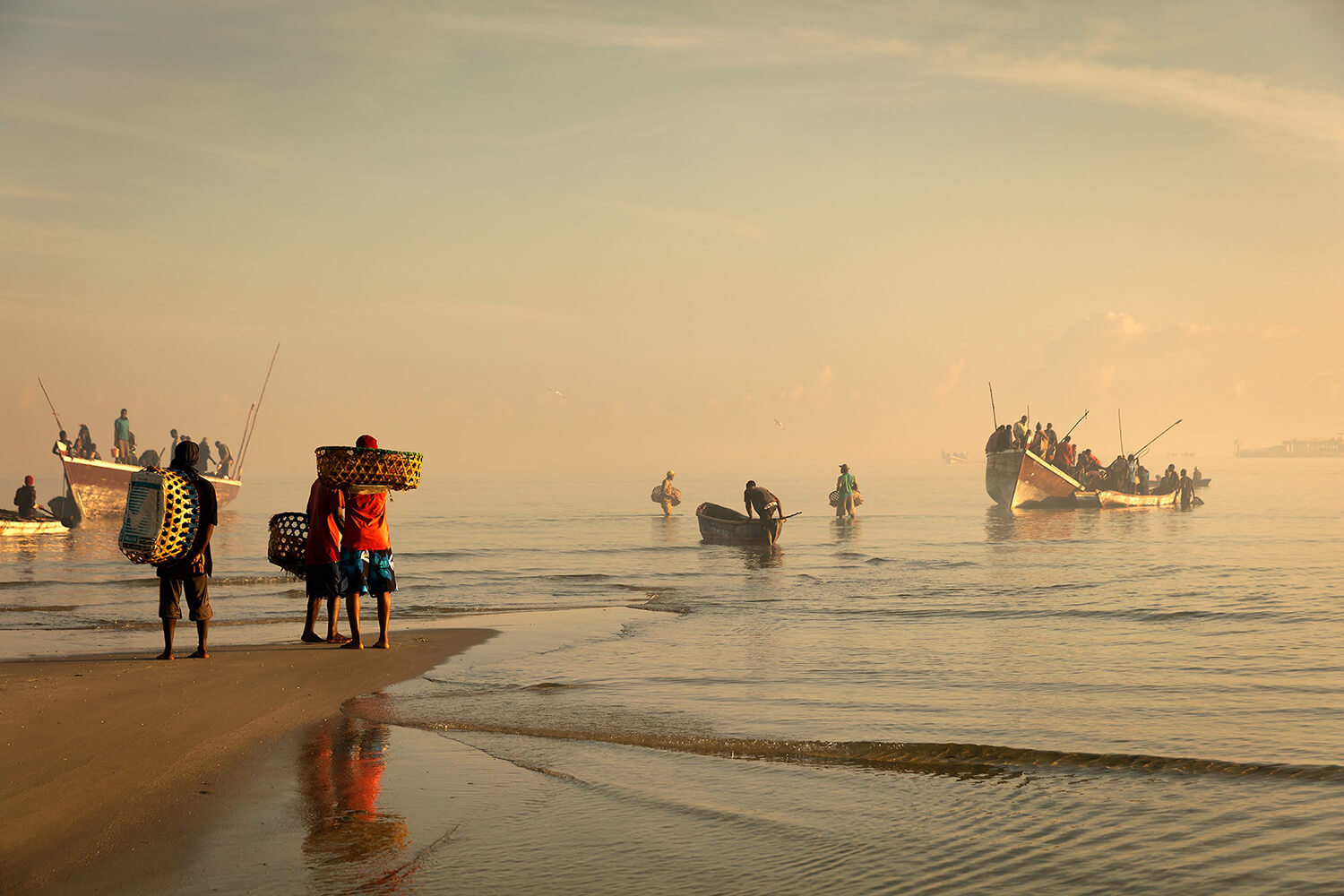
“Ocean seeps into sky, everything hazy, awash with pink, beige and blue. That soft, ethereal light, those pastel hues, give this painterly shot an almost mythical atmosphere. We can see human activity – figures, vessels, fishing rods, baskets – but no none of the subjects’ faces are visible so as viewers, we’re left to construct a narrative for this scene.” – RACHEL SEGAL HAMILTON
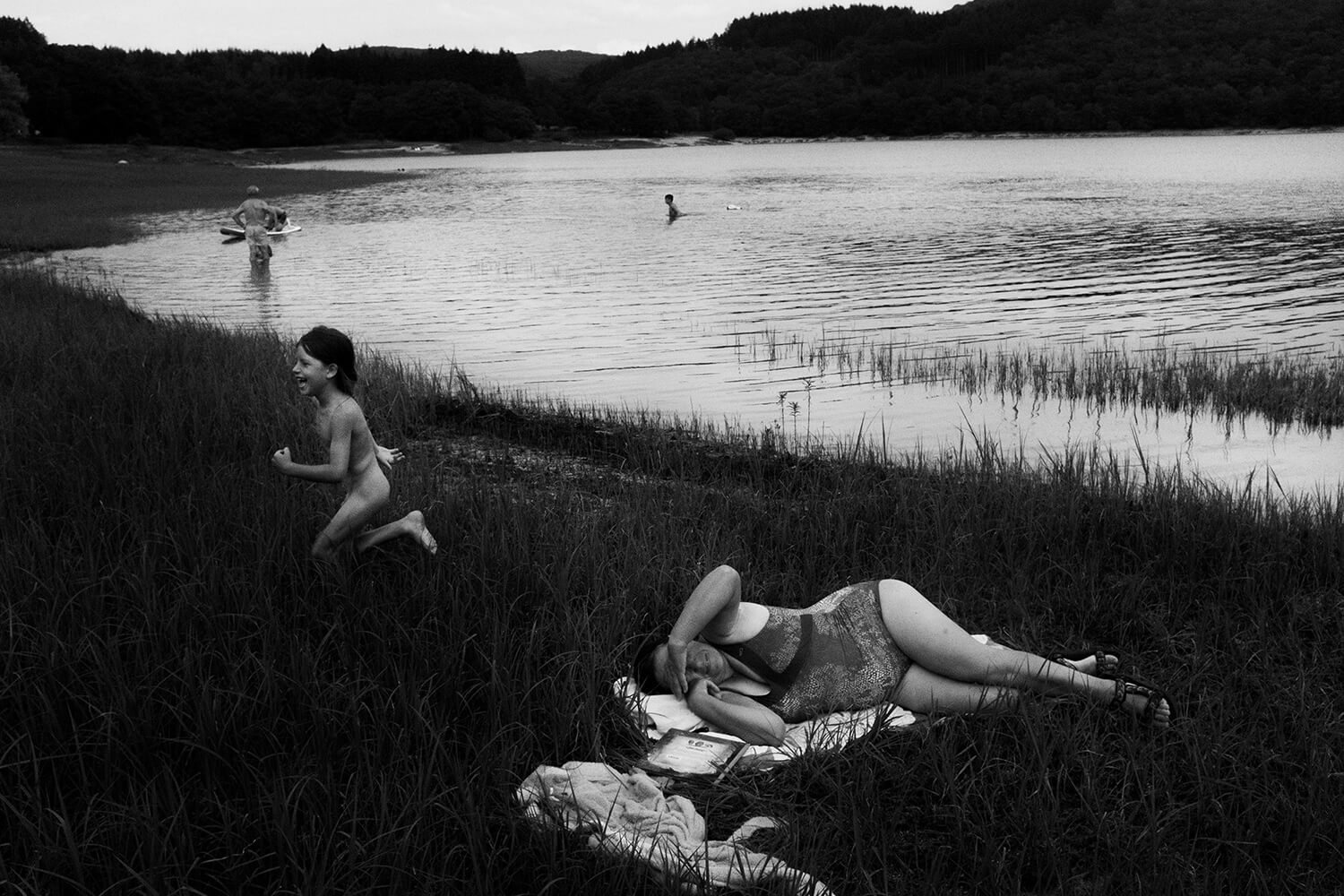
“I just love this picture from a documentary series about residents of Morvan in France. It makes me smile. It’s funny, surreal, so full of life. The zig zagging of the grassy verge, the luminous water, mountains have a pleasing geometry about them, while the sprinting child and lounging grandma in her floral swimsuit amount to a joyful intergenerational juxtaposition.” – RACHEL SEGAL HAMILTON
Photographer statement – From the series The Irreductibles. “This series focuses on people living in the Morvan (Burgundy, France), highlighting the ways in which they resist to maintain their social and cultural ties within their community. Started in May 2020 with the help of Nikos Economopoulos, it is destined to be enriched by my peregrinations. The photographic series focuses on unveiling the lives of people living in the Morvan with a wide gaze, that does not focus on a particular activity. If the territory is marked by agriculture, it is also animated by cultural, artistic and popular initiatives… which all combine to give it the dynamic that characterizes it.
Image: A grandmother and her grandson enjoy a sunny summer afternoon by the lake. France, 2020.”
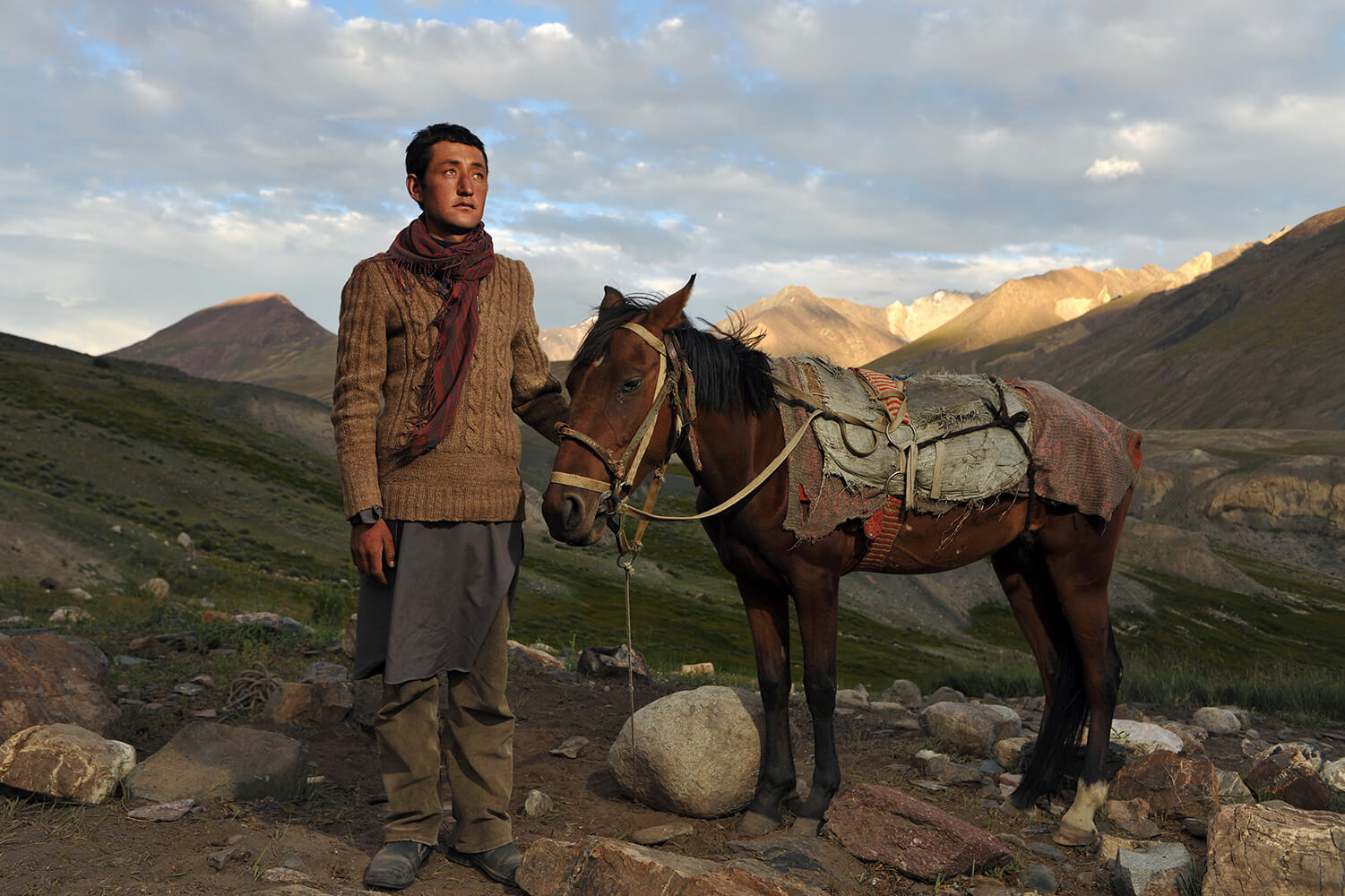
“In the spring of each year, the photographer’s statement informs us, Wakhi people such as this young man, living in north-eastern Afghanistan, undertake an annual spring migration along with their livestock in search of grazing land. This sweeping environmental portrait locates the young man surrounded by the rugged, breathtaking mountainous landscape he calls home. Captured in stunning natural light, he looks ahead somewhat uncertain, and we’re left to wonder why.” – RACHEL SEGAL HAMILTON
Photographer statement – “Every year Afghan Wakhis migrate with their livestock from the Wakhan Corridor to the highland pasturage of the Big and Little Pamir looking for meadows. During the annual seasonal migration, Wakhis use a walking trails network in order to bring supplies from the lower valley to the highland settlements. Their settlements are mainly between elevations of 4000m and 5000m. Little Pamir – Afghanistan – 2016”